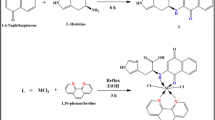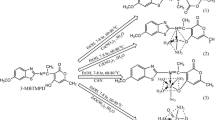Abstract
X-ray crystal and other structural analyses indicate that Yb(III) and all four newly synthesized ligands can form a binuclear Yb(III) complex with a 1:1 metal to ligand stoichiometry by octacoordination at the Yb(III) center. Investigations of DNA binding properties show that all the ligands and Yb(III) complexes can bind to Calf thymus DNA through intercalations with the binding constants at the order of magnitude 105–107 M−1, but Yb(III) complexes present stronger affinities to DNA than ligands. All the ligands and Yb(III) complexes may be used as potential anticancer drugs. Investigations of antioxidation properties show that all the ligands and Yb(III) complexes have strong scavenging effects for hydroxyl radicals and superoxide radicals but Yb(III) complexes show stronger scavenging effects for hydroxyl radicals than ligands.





Similar content being viewed by others
References
Albrecht M, Osetska O, Fröhliich R (2005) 2-[(8-Hydroxyquinolinyl)methylene]hydrazinecarboxamide: expanding the coordination sphere of 8-hydroxyquinoline for coordination of rare-earth metal (III) ions. Dalton Trans 23:3757–3762. doi:10.1039/b507621h
Ames BN, Shigenaga MK, Hagen TM (1993) Oxidants, antioxidants, and the degenerative diseases of aging. Proc Natl Acad Sci USA 90:7915–7922. doi:10.1073/pnas.90.17.7915
Ayar A, Mercimek B (2006) Interaction of nucleic acid bases and nucleosides with cobalt ions immobilized in a column system. Process Biochem 41:1553–1559
Bagatolli LA, Kivatinitz SC, Fidelio GD (1996) Interaction of small ligands with Human serum albumin IIIA subdomain. How to determine the affinity constant using an easy steady state fluorescent method. J Pharm Sci 85:1131–1132
Baldini M, Belicchi-Ferrari M, Bisceglie F, Pelosi G, Pinelli S, Tarasconi P (2003) Cu(II) complexes with heterocyclic substituted Thiosemicarbazones: the case of 5-Formyluracil synthesis, characterization, X-ray structures, DNA interaction studies, and biological activity. Inorg Chem 42:2049–2055
Barton JK, Danishefsky AT, Goldberg JM (1984) Tris(phenanthroline)ruthenium(II): stereoselectivity in Binding to DNA. J Am Chem Soc 106:2172–2176
Barton JK, Goldberg JM, Kumar CV, Turro NJ (1986) Binding modes and base specificity of tris(phenanthroline) ruthenium(II) enantiomers with nucleic acids: tuning the stereoselectivity. J Am Chem Soc 108:2081–2088. doi:10.1021/ja00268a057
Behrens C, Harrit N, Nielsen PE (2001) Synthesis of a Hoechst 32258 analogue amino acid building block for direct incorporation of a fluorescent, high-affinity DNA binding motif into peptides. Bioconjugate Chem 12:1021–1027
Berezhkovskiy LM, Astafieva IV, Cardoso C (2002) Analysis of peptide affinity to major histocompatibility complex proteins for the two-step binding mechanism. Anal Biochem 308:239–246
Chaires JB, Dattagupta N, Crothers DM (1982) Studies on interaction of anthracycline antibiotics and deoxyribonucleic acid: equilibrium binding studies on the interaction of daunomycin with deoxyribonucleic acid. Biochemistry 21:3933–3940. doi:10.1021/bi00260a005
Chen XM, Cai JW (2003) Single-crystal structural analysis. Principles and practices. Science Press, Beijing
Chen AY, Yu C, Gatto B, Liu LF (1993) DNA minor groove-binding ligands: a different class of mammalian DNA topoisomerase I inhibitors. Proc Natl Acad Sci USA 90:8131–8135. doi:10.1073/pnas.90.17.8131
Chiang SY, Welch J, Rauscher FJ, Beerman TA (1994) Effects of minor groove binding drugs on the interaction of TATA box binding protein and TFIIA with DNA. Biochemistry 33:7033–7040. doi:10.1021/bi00189a003
El-Asmy AA, El-Sonbati AZ, Ba-Issa AA, Mounir M (1990) Synthesis and properties of 7-formyl-8-hydroxyquinoline and its transition metal complexes. Transit Met Chem 5:222–225. doi:10.1007/BF01038379
Frau S, Bernadou J, Meunier B (1997) Nuclease activity and binding characteristics of a cationic “Manganese porphyrin-bis(benzimidazole) dye (Hoechst 33258)” conjugate. Bioconjugate Chem 8:222–231
Geary WJ (1971) The use of conductivity measurements in organic solvents for the charaterisation of coordination compounds. Coord Chem Rev 7:81–122
Guo ZY, Xing RE, Liu S, Yu HH, Wang PB, Li CP, Li PC (2005) The synthesis and antioxidant activity of the Schiff bases of chitosan and carboxymethyl chitosan. Bioorg Med Chem Lett 15:4600–4603. doi:10.1016/j.bmcl.2005.06.095
Hecht SM (1986) The chemistry of activated bleomycin. Acc Chem Res 19:383–391. doi:10.1021/ar00132a002
Hodnett EM, Dunn WJ (1972) Cobalt derivatives of Schiff bases of aliphatic amines as antitumor agents. J Med Chem 15:339. doi:10.1021/jm00273a037
Hodnett EM, Mooney PD (1970) Antitumor activities of some Schiff bases. J Med Chem 13:786. doi:10.1021/jm00298a065
Horton AA, Fairhurst S (1987) Lipid peroxidation and mechanisms of toxicity. Crit Rev Toxicol 18:27–29. doi:10.3109/10408448709089856
Hunter RB, Walker W (1956) Anticoagulant action of Neodymium 3-Sulpho-isonicotinate. Nature 178:47. doi:10.1038/178047a0
Ismail TMA (2005) Mononuclear and binuclear Co(II), Ni(II), Cu(II), Zn(II) and Cd(II) complexes of Schiff-base ligands derived from 7-formyl-8-hydroxyquinoline and diaminonaphthalenes. J Coord Chem 58:141–151
Kramsch DM, Aspen AJ, Rozler LJ (1981) Atherosclerosis: prevention by agents not affecting abnormal levels of blood lipids. Science 213:1511–1512. doi:10.1126/science.6792706
Krishna AG, Kumar DV, Khan BM, Rawal SK, Ganesh KN (1998) Taxol–DNA interactions: fluorescence and CD studies of DNA groove binding properties of taxol. Biochim Biophys Acta 1381:104–112
Li ZL, Chen JH, Zhang KC, Li ML, Yu RQ (1991) Fluorescent study on the primary screening for nonplatinum type of Schiff-base antitumor complexes. Science in China Series B: Chemistry 11:1193–1200
Lippard SJ (1978) Platinum complexes: probes of polynucleotide structure and antitumor drugs. Acc Chem Res 11:211–217. doi:10.1021/ar50125a006
Liu YC, Yang ZY, Du J, Yao XJ, Lei RX, Zheng XD, Liu JN, Hu HS, Li H (2008) Study on the interactions of Kaempferol and Quercetin with intravenous immunoglobulin by fluorescence quenching, Fourier transformation infrared spectroscopy and circular dichroism spectroscopy. Chem Pharm Bul 56:443–451
Lo SF, Mulabagal V, Chen CL, Kuo CL, Tsay HS (2004) Bioguided fractionation and isolation of free radical scavenging components from in vitro propagated Chinese medicinal plants Dendrobium tosaense Makino and Dendrobium moniliforme SW. J Agric Food Chem 52:6916–6919. doi:10.1021/jf040017r
Lu XH, Lin QY, Kong LC, He XQ (2006) Synthesis of binuclear rare earth complexes of N, N′-bis(2-pyri-dinecarboxamide)-1, 2-ethane and study on their Interaction with deoxyribonucleic acid. Chem Res Appl 18:1380–1385
Lu HL, Liang JJ, Zeng ZZ, Xi PX, Liu XH, Chen FJ, Xu ZH (2007) Three salicylaldehyde derivative Schiff base ZnII complexes: synthesis, DNA binding and hydroxyl radical scavenging capacity. Transit Metal Chem 32:564–569
Mahadevan S, Palaniandavar M (1997) Spectroscopic and voltammetric studies of copper(II) complexes of bis(pyrid-2-yl)-di/trithia ligands bound to calf thymus DNA. Inorg Chim Acta 254:291–302. doi:10.1016/S0020-1693(96)05175-4
McGhee JD, von Hippel PH (1974) Theoretical aspects of DNA-protein interactions: co-operative and non-co-operative binding of large ligands to a one-dimensional homogeneous lattice. J Mol Biol 86:469–489. doi:10.1016/0022-2836(74)90031-X
Moawad MM, Hanna WG (2002) Structural and antimicrobial studies of some divalent transition metal complexes with some new symmetrical bis(7-formylanil substituented-sulfoxine) Schiff base ligands. J Coord Chem 55:439–457
Ou-Yang JM (1997) Synthesis properties and characterization of the complexes of 2-(N-hexadecylcarbamoyl)-8-hydroxyqunoline. J Inorg Chem 13:315–319
Palchaudhuri R, Hergenrother PJ (2007) DNA as a target for anticancer compounds: methods to determine the mode of binding and the mechanism of action. Curr Opin Biotechnol 18:497–503
Parker D, Dickins RS, Puschmann H, Crossland C, Howard JAK (2002) Being excited by lanthanide coordination complexes: aqua species, chirality, excited-state chemistry, and exchange dynamics. Chem Rev 102:1977–2010. doi:10.1021/cr010452+
Pyle AM, Morii T, Barton JK (1990) Probing microstructures in double-helical DNA with chiral metal complexes: recognition of changes in base-pair propeller twisting in solution. J Am Chem Soc 112:9432–9434. doi:10.1021/ja00181a077
Satyanarayana S, Dabrowiak JC, Chaires JB (1992) Neither Δ-nor Λ-Tris(phenanthroline)ruthenium(II) Binds to DNA by classical intercalation. Biochemistry 31:9319–9324. doi:10.1021/bi00154a001
Scatchard G (1949) The attractions of protein for small molecules and ions. Ann N Y Acad Sci 51:660–673. doi:10.1111/j.1749-6632.1949.tb27297.x
Schmidt LH (1969) Chemotherapy of the drug-resistant malarias. Annu Rev Microbiol 23:427–454. doi:10.1146/annurev.mi.23.100169.002235
Sheldrick GM (1990) Phase annealing in SHELX-90: direct methods for larger structures. Acta Crystallogr A 46:467–473. doi:10.1107/S0108767390000277
Sigman DS, Mazumder A, Perrin DM (1993) Chemical nucleases. Chem Rev 93:2295–2316
Snyder RD (2007) Assessment of atypical DNA intercalating agents in biological and in silico systems. Mutat Res 623:72–82
Suh D, Chaires JB (1995) Criteria for the mode of binding of DNA binding agents. Bioorg Med Chem 3:723–728. doi:10.1016/0968-0896(95)00053-J
Ueda J-i, Saito N, Shimazu Y, Ozawa T (1996) A comparison of scavenging abilities of antioxidants against hydroxyl radicals. Arch Biochem Biophys 333:377–384
Wang Y, Yang ZY, Wang Q, Cai QK, Yu KB (2005) Crystal structure, antitumor activities and DNA-binding properties of the La(III) complex with Phthalazin-1(2H)-one prepared by a novel route. J Organomet Chem 690:4557–4563
Wang HL, Yang ZY, Wang BD (2006) Synthesis, characterization and the antioxidative activity of copper(II), zinc(II) and nickel(II) complexes with naringenin. Transit Met Chem 31:470–474. doi:10.1007/s11243-006-0015-3
Wang BD, Yang ZY, Crewdson P, Wang DQ (2007) Synthesis, crystal structure and DNA-binding studies of the Ln(III) complex with 6-hydroxychromone-3-carbaldehyde benzoyl hydrazone. J Inorg Biochem 101:1492–1504. doi:10.1016/j.jinorgbio.2007.04.007
Winterbourn CC (1979) Comparison of superoxide with other reducing agents in the biological production of hydroxyl radicals. Biochem J 182:625–628
Winterbourn CC (1981) Hydroxyl radical production in body fluids. Roles of metal ions, ascorbate and superoxide. Biochem J 198:125–131
Woynarowski JM, Mchugh M, Sigmund RD, Beerman TA (1989) Modulation of Topoisomerase II catalytic ativity by DNA minor groove binding agents distamycin, Hoechst 33258 and 4′, 6-Diamidine-2-phenylindole. Mol Pharmacol 35:177–182
Wu JZ, Ye BH, Wang L, Ji LN, Zhou JY, Li RH, Zhou ZY (1997) Bis(2, 2’-bipyridine)ruthenium(II) complexes with imidazo[4, 5-f][1, 10]-phenanthroline or 2-phenylimidazo[4, 5-f][1, 10]phenanthroline. J Chem Soc Dalton Tran 8:1395–1402
Xing R, Yu H, Liu S, Zhang W, Zhang Q, Li Z, Li P (2005) Antioxidant activity of differently regioselective chitosan sulfates in vitro. Bioorg Med Chem 13:1387–1392
Yang MM, Yang P, Zhang LW (1994) Study on interaction of caffeic acid series medicine and albumin by fluorescence method. Chin Sci Bull 9:31–36
Zeng YB, Yang N, Liu WS, Tang N (2003) Synthesis, characterization and DNA-binding properties of La(III) complex of chrysin. J Inorg Biochem 97:258–264. doi:10.1016/S0162-0134(03)00313-1
Zsila F, Bikádi Z, Simonyi M (2004) Circular dichroism spectroscopic studies reveal pH dependent binding of curcumin in the minor groove of natural and synthetic nucleic acids. Org Biomol Chem 2:2902–2910. doi:10.1039/b409724f
Acknowledgments
The study was supported by the National Natural Science Foundation of China (20475023) and Gansu NSF (3ZS 041-A25-016).
Author information
Authors and Affiliations
Corresponding author
Electronic supplementary material
Below is the link to the electronic supplementary material.
Rights and permissions
About this article
Cite this article
Liu, Yc., Yang, Zy. Crystal structures, antioxidation and DNA binding properties of Yb(III) complexes with Schiff-base ligands derived from 8-hydroxyquinoline-2-carbaldehyde and four aroylhydrazines. Biometals 22, 733–751 (2009). https://doi.org/10.1007/s10534-009-9221-8
Received:
Accepted:
Published:
Issue Date:
DOI: https://doi.org/10.1007/s10534-009-9221-8




